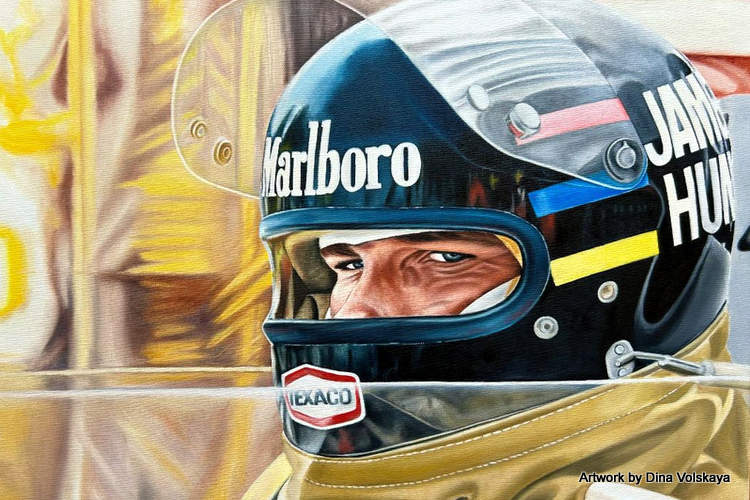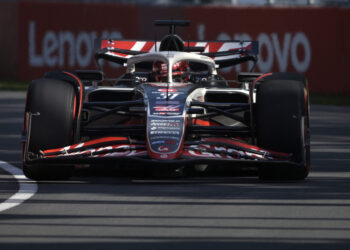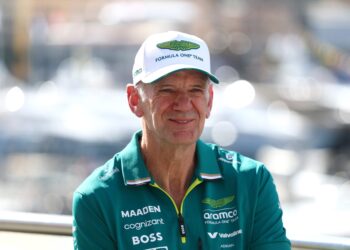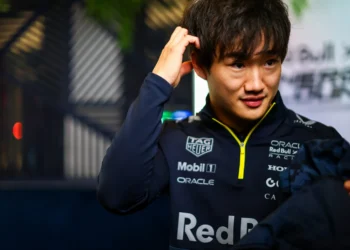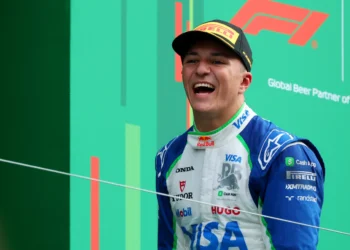Art by Dina Volskaya James Hunt
James Simon Wallis Hunt was born on August 29, 1947 and spent his early years in Surrey, England. Similar to Graham Hill, he discovered the thrill of car racing during a casual outing with friends at Brands Hatch when he was seventeen years old.
According to his then-girlfriend Taormina Rieck, he came alive during that experience. From an early age, Hunt realized that he would not have the support of his family in his racing endeavors, much like the Revson brothers. Determined to forge his own path, he took on various jobs, such as hospital porter, milkman, and courier, to finance his racing career. He also received additional “sponsorship” in the form of a loan.
James Hunt quickly stood out as a racing driver. From the moment he entered the world of racing, both on and off the track, he displayed remarkable speed and an explosive temperament. The late commentator Murray Walker once remarked that Hunt had the most intimidating temper he had ever witnessed.
Starting with a Mini, Hunt soon progressed to Formula Ford and achieved his first victory in 1968 at the Lydden Hill circuit near Dover. Midway through the 1969 season, he moved on to Formula 3 and secured a third-place finish at Brand Hatch in the 13th round of the Lombank British Formula 3 Championship, with American Roy Pike in second place and Emerson Fittipaldi as the race winner.
In 1970, Hunt embarked on his first full season in the British Formula 3 Championship, driving a Molyslip-sponsored Lotus 59. It was during this period that he gained the nickname “Hunt the Shunt” due to his aggressive driving style, which often resulted in collisions. From Monaco to Mosport Park, his explosive temperament was evident. In the October Daily Express Trophy at Crystal Palace, Hunt was involved in a battle with Dave Morgan on the final lap for a podium position. As they exited the final corner, the two cars collided. Morgan was penalized, but not before Hunt got out of his car, ran towards Morgan, and forcefully pushed him to the ground.
Hunt’s best results in this season were two second places. The first came in May at Oulton Park in the British Empire Trophy, and the second was in October at Brands Hatch in the E.R. Hall Trophy.
Hunt also had success in international Formula 3 competitions. A notable victory was achieved in a close race against Wilson Fittipaldi at the French street circuit in Rouen. Tragically, two French drivers, Denis Dayan and Jean-Luc Salomon, lost their lives during this race. Another thrilling victory came against fellow Englishman Barrie Maskell at Zolder in Belgium.
In the 1971 season, James Hunt remained in Formula 3 racing but joined Max Mosley’s March team. He secured victories at Montlhery, near Paris, against Jean-Pierre Jabouille and Patrick Depailler, who were driving for Alpine-Renault and would later win the French Grand Prix. Hunt also emerged victorious at the Nürburgring Südschleife against three local drivers.
In the Crystal Palace circuit, Hunt triumphed in the Chris Moore Memorial Trophy, defeating Roger Williamson. Tragically, Williamson would lose his life in a fiery accident at the 1973 Dutch Grand Prix. Hunt’s fourth and final F3 victory of the season came at Brands Hatch, with Williamson finishing in second place. Colin Vandervell, son of Tony Vandervell from Vanwall, took third place on the podium. Jody Scheckter and Alan Jones, both future world champions, completed the top five.
Continuing his association with March in the 1972 Formula 3 season, Hunt only secured one podium at Mallory Park circuit, where he secured third place.
Lord Alexander Hesketh, a young English aristocrat and heir to a great fortune, owned a Formula 3 team. Initially, the team hired Anthony “Bubbles” Horsley as a driver, but it became evident that they needed a faster driver. When Hesketh met James Hunt, he quickly decided to hire him as a driver and promoted himself to team manager.
The partnership between Hunt and Hesketh Racing began with a few races in Formula 3, where they failed to reach the podium. They then ventured into Formula 2, driving a March 712M. They achieved a third place at the Oulton Park circuit, with Ronnie Peterson and Niki Lauda occupying the first two positions. These two drivers would later become rivals of Hunt in the Formula 1 championship.
According to Hunt, as the team was not succeeding in Formula 2, Lord Hesketh, affectionately known as The Good Lord, decided to transition to Formula 1.
Hesketh Racing made a grand entrance into Formula 1 at the prestigious Monaco Grand Prix in 1973. They arrived in style, using a Rolls-Royce Corniche and a Porsche Carrera for transportation, while enjoying moments of relaxation on Hesketh’s luxurious 162-foot yacht, the Southern Breeze. The yacht was properly stocked with champagne and attractive women, adding to the carnival atmosphere in the F1 paddock.
Piloting a March, Hunt was in sixth place in the championship when he had to retire on lap 73 of 78 due to an engine failure. The first time they finished on the podium was in the Netherlands, and their best result of the season came in the final race at Watkins Glen, where Hunt finished just 0.6s behind Peterson’s Lotus.
A young Dr. Harvey Postlethwaite designed the Hesketh 308, and with the updated 308B at the 1975 Dutch Grand Prix, Hunt surprised everyone, including Scuderia Ferrari and Niki Lauda, by holding off Lauda for over thirty laps in changing conditions and securing a memorable victory.
Hesketh Racing, known as the “Hooray Henry” of Formula 1, had just achieved their first and only Grand Prix victory. This would also be their only success at the highest level of motorsport.
After the 1975 season, Emerson Fittipaldi left McLaren to join his brother’s Copersucar team. This opened up an opportunity for Hunt to join a championship-winning team, which at the time was managed by an American lawyer named Teddy Mayer.
In their first race together in Brazil, Hunt qualified in first place. However, he crashed on lap 32 of 40, while Lauda won the race. Little was known at the time, but this race set the stage for an exciting season full of unexpected twists and turns, culminating in the final lap of the last race.
The pattern continued in the second race of the season at Kyalami, South Africa. Hunt once again qualified on pole, but Lauda emerged as the race winner. This time, Hunt managed to secure a place on the podium, finishing second.
Hunt’s first victory of the season came in the 4th round at Jarama, in the Spanish Grand Prix. This victory came after his disqualification for exceeding the car’s width limit was overturned. Lauda had already won four of the first six races, including the Monaco Grand Prix, and seemed poised for his second consecutive title with Scuderia.
Hunt crossed the finish line in first place at Paul Ricard and Brands Hatch, but was subsequently disqualified from his home Grand Prix. The turning point came at the German Grand Prix at the Green Hell, where Lauda was rescued from his burning car by Arturo Merzario, an Italian driver. Hunt won the race.
He also emerged victorious at the Dutch Grand Prix before Lauda made a remarkable recovery and finished fourth at Monza. Carlos Reutemann, driving a third car for Commendatore, finished ninth, while Regazzoni, another teammate, came second behind Peterson, securing Peterson’s third victory at the Temple of Speed.
The first Japanese Grand Prix at the Fuji circuit marked an exciting conclusion to the season, with Hunt emerging victorious in the previous races held in Canada and the United States. However, heavy rain caused a delay in the season finale, which eventually took place in challenging monsoon conditions.
During the race, Lauda made the strategic decision to stop on the second lap for his own safety. Meanwhile, Mario Andretti secured the victory from pole position, marking his first win since his debut triumph in 1971 at Kyalami. Hunt, on the other hand, braved the treacherous storm and secured a place on the podium, unaware that he had become the new World Champion.
Shortly after the race, Hunt was interviewed by a journalist in England over the phone. When asked about his immediate plans, Hunt’s immediate and honest response was, “I must get drunk.”
However, Hunt’s tumultuous lifestyle, both on and off the track, eventually caught up with him. Struggling with alcohol, drugs, failed relationships, and unsuccessful business ventures, he found himself in a difficult situation where his Mercedes 450 SEL was left on blocks to avoid vehicle tax payment. In a poignant YouTube video, Lauda, a great rival and close friend of Hunt’s, recalls their encounter in London, where the 1976 World Champion couldn’t even afford a cup of coffee.
Tragically, Hunt suffered a fatal heart attack on June 15, 1993, at the young age of 45.
Throughout his career, James Hunt competed in 92 Grand Prix races, secured 14 pole positions, won 10 races, and stood on the podium in 23 events. He left a lasting legacy as a true champion, at least on the racetrack.
© 2024
Portugal clinches Euro Cup title in thrilling final against Germany
The Portuguese national football team made history by clinching the Euro Cup title in a thrilling final against Germany. The match, which took place at Wembley Stadium in London, ended with Portugal’s victory with a score of 2-1.
The match started with Germany pressing and dominating the game. However, Portugal defended well and took advantage of counter-attack opportunities. It was in one of these counter-attacks that Cristiano Ronaldo opened the scoring for Portugal in the 30th minute of the first half.
In the second half, Germany came back strong and equalized the game in the 55th minute, with a goal from Müller. The match became even more intense, with both teams seeking the winning goal. And it was Cristiano Ronaldo who shone again, scoring the winning goal for Portugal in the 80th minute.
With this victory, Portugal became the European champions for the second time, repeating the feat of 2016. The Portuguese team showed a lot of determination and resilience throughout the tournament, overcoming strong opponents and playing high-level football.
Portugal’s victory also crowns Cristiano Ronaldo as one of the greatest players in the history of football. The Portuguese superstar scored decisive goals and led the team with mastery, demonstrating all his skill and experience.
The Portuguese fans celebrated the victory, filling the streets of Portugal with joy and celebration. The players were received as heroes and the Portuguese national team entered the history of football.
Now, the focus turns to the next edition of the European Championship, which will be held in 2028. Portugal is already preparing to defend the title and continue shining on the field. The Portuguese national team has shown that it is one of the great powers of European football and promises to continue bringing a lot of joy to its fans.

